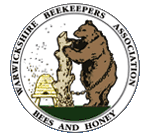Does the weather always have the last say? An incredible spring saw a record number of swarms and people running out of equipment, but also very good honey crops. The weather was such that in our area for the first time many of us could remember as beekeepers none of the nectar pollen sources were denied the bees by severe weather either ruining the source and/or preventing the bees flying.
This year bees worked the mahonia, aconites and snowdrops through to the apples, horse chestnut and, of course, OSR, without interruption. But what about the summer? Very strong colonies are going into the summer season.
The weather has been less kind – much more rain and a lot of storms. One member reported large areas of a phacelia crop and large areas of a developing wildflower meadow flattened by storms. What can we expect from the bees in terms of the summer harvest? The bees have certainly had more restricted flying days.
One interesting discussion was whether the genetics of the colony makes any odds. One member described two colonies growing equally well post spring, but with a sudden change when the inclement weather struck. One colony developed, albeit more slowly, and the other was clearly in negative equity, eating more than it was bringing in. Another member suggested that carnelian queens tended to head hungry colonies. There wasn’t time to find a more expert view or look for learned articles.
The honey regulations and food safety issues are often discussed. It is interesting to record some observations of travelling abroad. Reports of thyme honey from Crete where huge areas of rocky mountainside were covered in thyme. The thyme honey taste matched the thyme honey label. There did not appear to be any scientific assessment of the thyme content – as far as language barriers allowed confirmation.
In French markets there are always bee products for sale. In one market one member saw wax wraps, homemade soaps and hand creams being sold, all unlabelled. One beekeeper was selling several single-source honeys. His forest honey came from a wonderful site where he keeps colonies on the edge of a forest. Superb for the bees, and nicely sheltered from the weather, with easy access to the forest and also all the crops in the large area fields on three sides of the hives. There wasn’t time to discuss all the other single-source honey being sold.
Steve Brown
